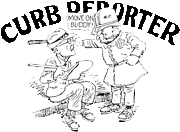Making mud for a master

For college students, summer employment is vital not only for monetary reasons, but also for learning about the world of work. I worked at Hatch Mill during the first two summers of my collegiate years. My mother was a cloth inspector at Hatch and helped get me the jobs. The summer of my freshman year I worked as a yarn boy loading spools of yarn onto forty or fifty looms for a weaver. The weavers were paid according to their production in cloth yards and got very belligerent if their yarn boy was tardy with the yarn or put it on wrong, shutting down the loom. The next summer I worked as a Frequency Checker in the Quality Control division at Hatch. The title sounds fancy, but it encompassed writing down each time a person spinning yarn took time off from the task at hand. I timed their lunch break, their conversations with other spinners, and even their bathroom breaks. Needless to say, I wasn't the most popular man in town that summer.
The third summer before my senior year at Wofford College I got a job that was physically demanding; yet, rewarding in many ways. I worked that summer for a true craftsman in the art of bricklaying, George Parker.
Each morning that summer, George and his son, John, would come by my house about six-o'clock in their somewhat dilapidated pickup truck. I would jump into the back and jam my skinny body between a concrete encrusted wheelbarrow and other tools. After a short bumpy ride, we would arrive at the building site.
I had two primary tasks during the day. I made and mixed the concrete known in bricklaying jargon as "mud"; and I carried the "mud" and bricks to Mr. Parker and his son. The fancy motorized mortar mixing machines did not exist at that time. I had to mix the right amount of sand and cement with a big hoe that had two large holds in the blade to allow the mix to flow through it. After mixing the sand and concrete in a wooden boxlike trough, I had to slowly mix water into the dry ingredients to the exact consistency that Mr. Parker demanded. If the "mud" did not meet his standard, I would receive a strong reprimand and the bucket of mortar would be thrown behind the newly constructed wall.
In between the "mud" making and carrying it to mortarboards along the brick wall, I had to keep Mr. Parker and his son supplied with bricks. This involved grabbing a stack of six or eight bricks with a hook and carrying them up a scaffold that varied in height.
Usually, I had barely caught up with the brick supply when one or both of the Parkers would yell for more "mud". While I made a new batch of "mud", the call for more bricks would ring out.
The job was hard and nerve-racking; however, it had its rewards. I made a good salary and I was able to observe a master craftsman at work. Mr. Parker would slap an exact amount of mortar on a brick and delicately lay it in perfect alignment by gently tapping on it. But, his true genius was demonstrated when he built corners and arches. For some reason unknown to me, bricks must be cut in half sizes to construct a corner. Today, most bricklayers use a water saw to cut bricks in half. George Parker could hold a brick in one hand and strike it in a certain place and at a certain angle with his trowel. Amazingly, the brick would break into two perfect halves. To build an arch, modern bricklayers use a plywood form to shape and hold the arch in place. George formed the arch using a keystone brick and several delicate procedures that only a true artist could maneuver. I am certain that many of the area's finest examples of brick work came from his hands.
Each afternoon around six o'clock, I returned home in the back of the truck exhausted and looking like one of those Australian natives that rub mud all over their bodies for ritual purposes. Yes, I had other summer jobs that were easier on my body, but none as aesthetically rewarding as working for the Parkers, true artists in a rustic setting.
Footnote: I received an e-mail from Gene Green who lived in "Mill Town" for most of his young life. His brother, Leon, was in my high school class. Gene expressed his appreciation of the column and related information about "Mill Town" and his father, Romey, who worked as a mechanic for Guynell Smith for fifteen years. The senior Mr. Green later fixed cars at his home in "Mill Town" and would sometimes fix cars in return for people working in his garden!
At the age of eighty-five, Gene's mother still lives there in the family homestead. Thanks, Gene and keep those memories coming in to s.hefner@comcast.com.

